Tai Chi meditation is all about finding balance and peace in a gentle way. It combines slow, mindful movements with deep breathing, offering a unique opportunity to relax while staying active. Whether you’re looking to reduce stress, enhance your focus, or just enjoy a calming practice, Tai Chi has a lot to offer for both the body and mind.
Improved Balance and Coordination
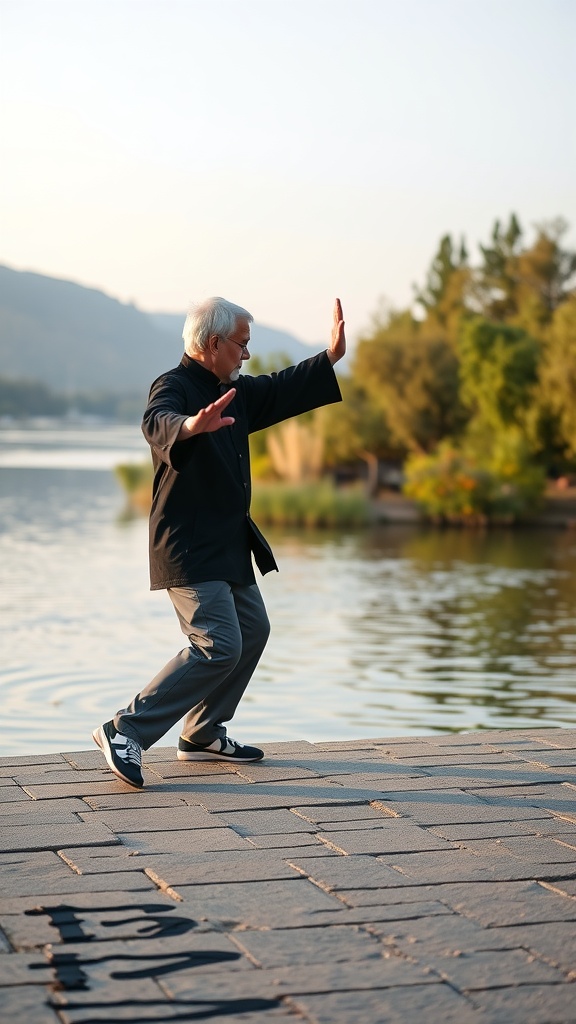
In the image, we see a person practicing Tai Chi by a serene body of water, which perfectly captures the essence of this gentle martial art. Tai Chi involves slow, deliberate movements that require a good degree of concentration and focus. This practice not only helps with relaxation but also enhances balance and coordination.
When you engage in Tai Chi, you’re essentially training your body to move fluidly and maintain stability. Each posture and transition challenges your balance, helping to strengthen the muscles that support your joints. This is particularly beneficial as we age, as it can help prevent falls and improve overall mobility.
Moreover, the rhythmic nature of Tai Chi encourages better coordination. As you flow from one movement to the next, your brain becomes more attuned to your body’s positioning and movement. Practicing these movements regularly can lead to improved motor skills and body awareness, making everyday tasks easier.
So, whether you’re looking to boost your physical stability or simply enjoy a peaceful moment by the water like the person in the image, Tai Chi offers a wonderful path to achieving that balance and coordination in your life.
Boosted Immune System Function
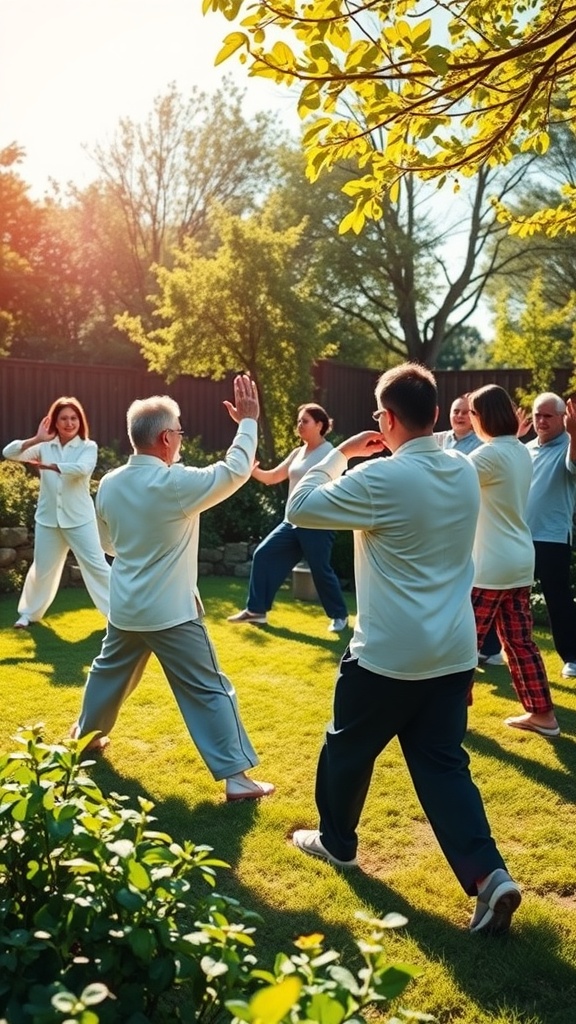
Engaging in Tai Chi can significantly support your immune system, making it more resilient against colds and infections. The image beautifully captures a group of people practicing Tai Chi outdoors, surrounded by nature. This serene setting adds to the relaxation and mindfulness that comes with the practice.
The slow, deliberate movements of Tai Chi help reduce stress, which is crucial for a healthy immune response. As seen in the image, participants focus on their postures and breathing, creating a calming environment. This focus can lead to lower levels of cortisol, a stress hormone that can weaken immune function.
Moreover, the social aspect of doing Tai Chi in a group, as shown here, encourages connection and support among participants. This sense of community can further enhance emotional well-being, leading to better overall health. Regular practice not only helps to maintain physical fitness but also promotes mental clarity, both of which contribute to a stronger immune system.
Increased Flexibility and Mobility
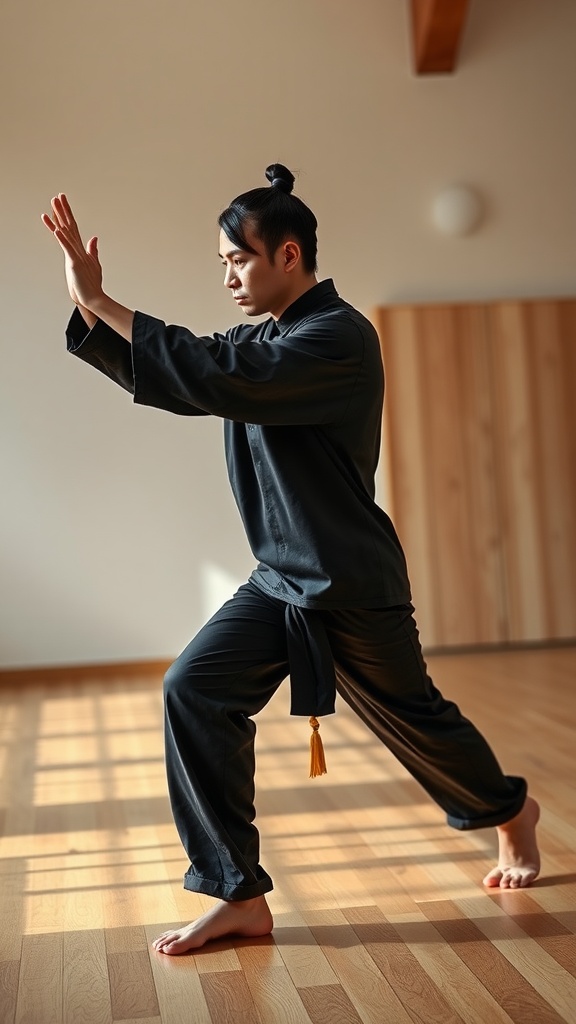
In the image, we see a person practicing Tai Chi, showcasing a graceful movement that highlights one of the key benefits of this ancient martial art: increased flexibility and mobility. The individual, dressed in a traditional outfit, is focused and balanced, embodying the flow of energy that Tai Chi promotes.
As you engage in Tai Chi, you gradually stretch and strengthen your muscles. This practice encourages fluid movements that help improve your overall range of motion. With regular practice, you’ll find that your body becomes more adaptable, making daily activities easier and more enjoyable.
Furthermore, Tai Chi emphasizes slow, deliberate movements. This not only enhances physical flexibility but also promotes mental awareness. You learn to move mindfully, which helps prevent injuries and fosters a deeper connection with your body.
Overall, incorporating Tai Chi into your routine can lead to noticeable improvements in how your body feels and functions. So, whether you’re a beginner or have some experience, there’s always room to grow and enjoy the benefits of increased flexibility and mobility.
Pain Relief and Management
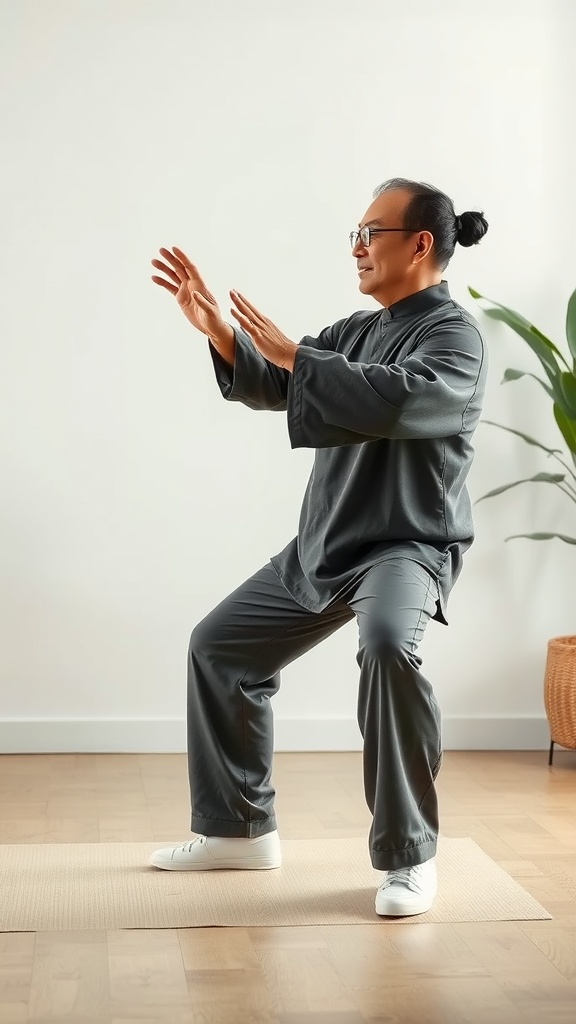
Tai Chi is often recognized for its gentle, flowing movements, which can be particularly beneficial for pain relief. In the image, we see a practitioner demonstrating a classic pose, embodying the essence of this ancient practice. The calm and focused demeanor reflects the meditative quality of Tai Chi, making it an excellent choice for those seeking to manage chronic pain.
The slow, deliberate movements help promote relaxation and reduce tension in the body. This is crucial for anyone dealing with discomfort, as tight muscles can exacerbate pain. Regular practice encourages better blood circulation, which is key in alleviating soreness and stiffness.
Moreover, Tai Chi is a low-impact exercise, making it accessible for people of all ages and fitness levels. This approach allows individuals to engage in physical activity without the fear of injury, a common concern for those with existing pain issues. By integrating breath and movement, practitioners can also enhance their overall sense of well-being.
Additionally, the mindfulness aspect of Tai Chi encourages mental clarity and emotional balance. Stress and anxiety can often lead to physical pain, so learning to relax the mind is just as important as relaxing the body. Overall, Tai Chi serves as a holistic method for not only managing pain but also improving one’s quality of life.
Enhanced Mental Clarity
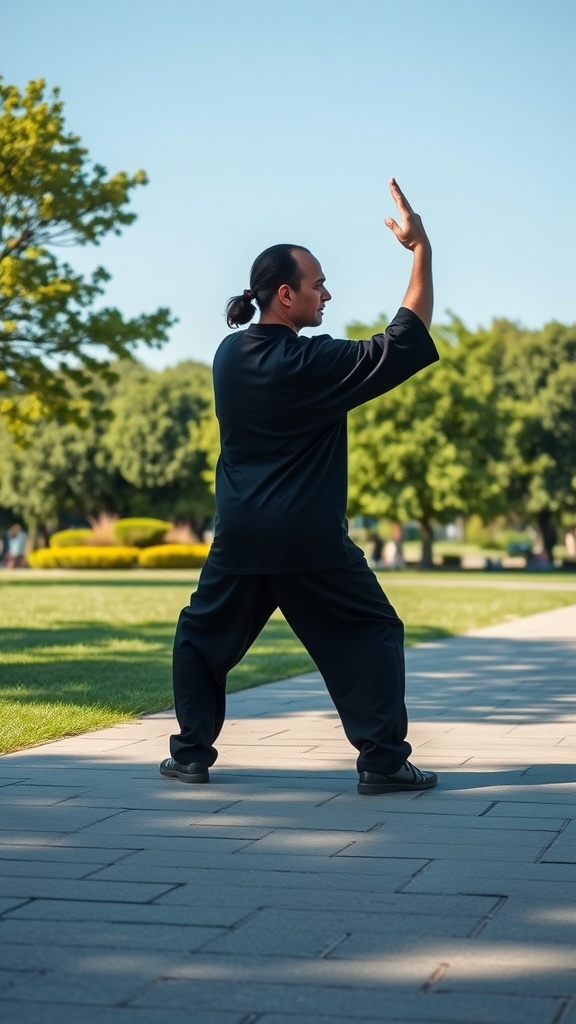
Engaging in Tai Chi can significantly boost your mental clarity. This gentle form of exercise encourages a deep connection between the mind and body. As seen in the image, the practitioner moves with grace and focus, embodying the essence of mindfulness.
The slow, deliberate movements allow you to quiet your mind. This tranquility is important for clearing mental clutter and enhancing concentration. It’s like giving your brain a much-needed break from the noise of daily life.
Additionally, practicing Tai Chi outdoors, as depicted, brings the added benefit of nature. Being in a serene environment can further elevate your mood and help you think more clearly. The fresh air and green surroundings create a peaceful backdrop that supports mental relaxation and focus.
As you immerse yourself in the practice, you may find that your thoughts become clearer and more organized. This clarity can lead to better decision-making and increased creativity. So, if you’re looking to sharpen your mind, integrating Tai Chi into your routine might be a great step.
Stress Reduction Techniques

In today’s fast-paced world, finding effective ways to reduce stress is essential. Tai Chi, often described as ‘meditation in motion,’ is an excellent practice to help calm the mind and body. The image captures a person practicing Tai Chi at sunrise, surrounded by serene nature. This peaceful setting enhances the calming effects of the exercise.
The gentle movements of Tai Chi encourage relaxation and mindfulness. As shown in the image, the individual is in a focused stance, demonstrating how Tai Chi practitioners often flow through movements with intent. This not only aids in stress reduction but also improves body awareness.
Many people find that practicing Tai Chi outdoors, as depicted here, deepens their connection with nature, which can be incredibly soothing. The tranquility of the water and the warm glow of the sunrise further emphasize the calming atmosphere that Tai Chi promotes. Engaging in this practice regularly can lead to a more centered and peaceful state of mind.
Incorporating Tai Chi into your routine can be as simple as dedicating a few minutes each day to practice. Whether in a park or your backyard, focusing on your breath and movements can help clear your mind and alleviate tension.
Improved Sleep Quality

The image showcases a person practicing Tai Chi under a starry sky, promoting a calm and serene atmosphere. This peaceful setting illustrates one of the many benefits of Tai Chi meditation: improved sleep quality.
Engaging in Tai Chi can help calm the mind and reduce stress. By focusing on slow, deliberate movements, practitioners often find it easier to unwind after a long day. This relaxation can lead to a more restful night’s sleep.
Moreover, Tai Chi encourages mindfulness. When you concentrate on your breathing and movements, it helps clear away racing thoughts that can interfere with falling asleep. Over time, this practice contributes to a more consistent sleep schedule.
Additionally, the gentle exercise involved in Tai Chi helps release tension in the body. This release can make it easier to drift off at night, as the body feels more relaxed and at ease.
So, if you’re struggling with your sleep, incorporating some Tai Chi into your routine might just do the trick!
Enhanced Mind-Body Connection

The image captures a person practicing Tai Chi in a serene environment, surrounded by softly glowing candles. The gentle light streaming through the room adds to the calm atmosphere, making it perfect for meditation.
Tai Chi is not just about movement; it’s a beautiful blend of body and mind. When you practice, you become more aware of your body movements and how they relate to your thoughts and feelings. This awareness helps strengthen the connection between how you feel and how your body responds.
As you go through the slow, flowing motions of Tai Chi, you can focus on your breath and your posture. This mindfulness can clear your mind, reducing stress and anxiety. When you immerse yourself in the practice, it almost feels like you’re in a dance with your own body.
Practicing in a peaceful space, as shown in the image, enhances this experience. The calming presence of candles and soft lighting invites a deeper level of focus and tranquility, allowing for a greater connection to your inner self.
Social Interaction and Community
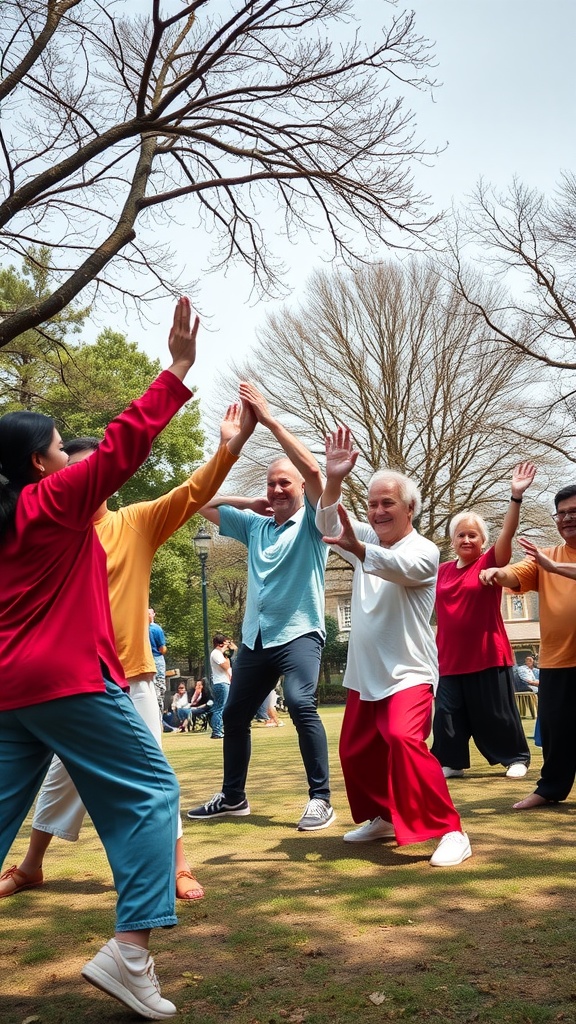
In the image, a diverse group of people engages in a lively Tai Chi session outdoors. They are all smiling and seem to be enjoying each other’s company, which highlights a key benefit of practicing Tai Chi: social interaction. This gentle form of exercise is often done in groups, making it a great way to meet new friends and strengthen existing relationships.
Tai Chi classes create a welcoming environment where individuals can connect with others who share similar interests. Participants often become a close-knit community, supporting each other both in practice and in life. These connections can lead to lasting friendships and a sense of belonging.
Additionally, practicing Tai Chi together fosters a sense of teamwork. As group members learn and grow together, they share tips and encouragement. This camaraderie makes the experience more enjoyable and can motivate individuals to stick with their practice.
Holistic Health Benefits
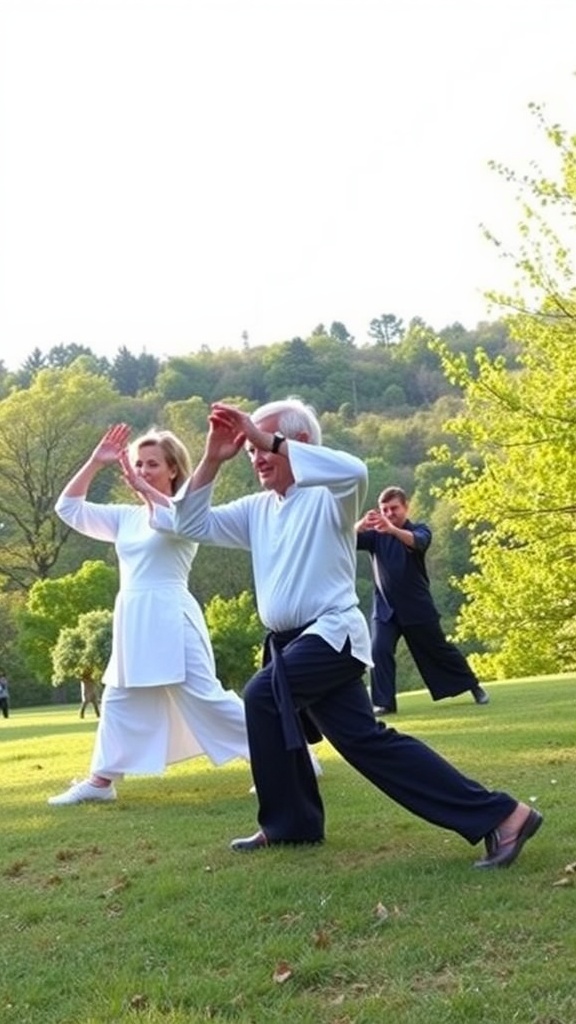
In the image, we see a group of individuals practicing Tai Chi outdoors. They are dressed in comfortable clothing, showcasing the relaxed nature of this ancient practice. It’s clear that they are focused and engaged, embodying the essence of Tai Chi as a form of moving meditation.
Tai Chi is more than just a series of graceful movements; it offers a range of holistic health benefits. It helps improve balance and flexibility, making it easier to perform daily activities. As you watch practitioners like those in the image, you can appreciate how the slow, deliberate motions promote physical stability.
Another fantastic aspect of Tai Chi is its ability to reduce stress. The flowing movements, combined with deep breathing, create a calming effect. This can lead to improved mental clarity and emotional balance, which is so important in today’s fast-paced world.